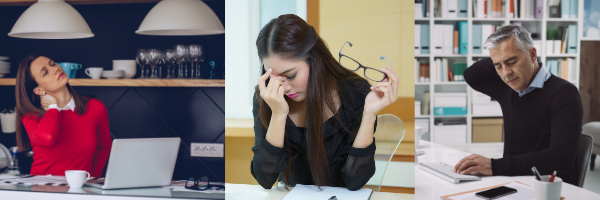- How is your neck?
- Is your back stiff and/or sore?
- Are your hips hesitant to move when you stand from your desk?
- How is your overall body after working at your “home office?”
If you find your answers are a little troubling, then this blog is PERFECT for you.
We’re all struggling with too much desk/device time. Overcoming physical inactivity is one of the new challenges of the modern world (especially during Covid.) With so many of us holding a work-around-the-clock mentality, or having to move our work into our homes, it’s almost unavoidable to fall into a lifestyle much more sedentary than we’re used to. We all seem to put more hours in at our desks when working from home and not able to do all our “normal” activities! I know I’m feeling it, so I asked my friend, Celeste Etlinger, a 15-years Pilates professional and owner of Essex Pilates & Wellness, to put together some info to help us combat the negative impact of sitting at a desk and prevent future discomfort and pain.
Celeste is going to help us explore:
- What happens to your body when you sit for long periods of time, especially in poor posture.
- How stepping away from your desk — even briefly — can combat the uncomfortable impacts of sitting too long (aka: being dedicated, focused, and passionate about your work).
- Stretches and strategies you can easily implement throughout your work day to combat negative effects of the dreaded, and all too typical, overly long work day.
The Perfect Desk Setup VS Our Reality
We’ve all seen the images of proper ergonomics for working at a desk. You know the perfect set up: 90 degree bends at ankles, knees, hips etc. with the top of our monitor at eye height. That’s difficult to achieve even when we have the perfect desks, chairs, and monitor setup! Our reality rarely looks like that perfect set up.

When we sit at our “desks” (yes, I’ll be putting desks in parentheses throughout because I have no idea where you’re actually working these days), all that goes right out the window. We often get so engrossed in what we’re doing we don’t move. Without physical meetings to make us get up, we could literally be in the same spot for hours. So, let’s take a brief look, from the ground up, at what happens to our bodies when we sit for long periods of time, especially when not in the ideal posture.
Negative Impacts of Sitting Too Long
Poor Circulation
Blood flows from the veins of the lower limbs back to the heart using muscular contractions within the feet and legs when we walk and move through our lives. This circulation is decreased with long bouts of sitting and inactivity.
Dead Butt Syndrome
This sounds terrible right? Right! Butt – ha, yes, but sitting for long periods of time can cause gluteal amnesia (aka Dead Butt Syndrome). Yes, you heard that correctly. This is when the blood flow to the gluteal muscles is slowed, consequently muscles stops firing properly. This can lead to back and hip pain and dysfunction.
Disc Issues
Poor skeletal alignment of the spine causes uneven pressure in the discs, which weakens them. This can increase the risk of herniated and/or ruptured discs.
Head Forward Position (a.k.a. TechNeck, iHump)
Did you know that for every inch your head is forward of its ideal alignment, it puts an extra 10 pounds pressure on your neck?
These deviations can take the average 10-12 lb head and cause it to put up to 60 pounds of pressure on your neck — OUCH! Now, look down at your phone or devise when it’s at about chest height … you’re facilitating the iHump. Now, please, raise your phone about nose height. Your neck and back thank you.

What To Do?
While heart-pumping exercise offers great health gains, the good news is that studies suggest that moving your body and taking short and frequent breaks away from your desk can do wonders for your body (as well as your mind, but that’s a different topic.)
I’ve designed a simple flow of stretches that you can do right at your desk — whatever that might look like these days.
And here are some simple strategies you can implement into your day to help combat the negative impacts of sitting too long:
- Set an alarm or timer to remind you to get up and step away from your “desk” every hour. This can be for as little as 2-3 minutes.
- If you need to get water or another cup of coffee, use the bathroom, and go to the printer, try doing each task separately instead of all at once. Walk to the bathroom then go back to your “desk” and choose a stretch. Then, walk to get a glass of water and go back to your “desk” to sit, and so on. Breaking these tasks up throughout the day will help you stay active.
- If you have to make a phone call, get up and walk around while you chat. When back at your “desk,” choose a stretch then get back to work.
The best way to see how this works for you is to check in with your body, specifically, neck, shoulders, back, hips, and ankles after you work for 2-4 hour straight at your “desk,” and note how you feel. Then, implement these techniques for one month. At the end of the month, check back in with your body. It’s going to be thanking you by “yelling at you” less. How exactly does your body yell at you? With aches, pains, stiffness, and inflammation. These symptoms are your body’s way of communicating with you that it’s not happy. If you use these techniques, you should notice a difference.
Desk Stretches that Work!
I’ve developed a helpful flow of a few simple exercises that can help make your day easier on your body. Originally titled, “Stretches for Desk Workers,” I’m now calling it, “Stretches for Desk–, Kitchen Table–, Coffee Table–, Couch–, Car–, Dorm Room–Workers” because really, where IS your office these days and how is this effecting your body?
- View the Stretches guide webpage.
- Download the “Stretches for Stretches for Desk–, Kitchen Table–, Coffee Table–, Couch–, Car–, Dorm Room–Workers” Guide.
- Watch a video demonstration of these suggested desk stretches and movements.
Guest Post by Celeste Etlinger

Celeste Etlinger, founder of Essex Pilates & Wellness
Celeste Etlinger’s chiropractor introduced her to Pilates in 2003 to help with chronic back pain. Within only three months, she was feeling such positive results in her body, she was completely hooked. In 2005, she decided she wanted to start teaching this remarkable exercise method … and she’s never looked back.
She’s on a mission to inspire people to lead healthier, more productive lives by teaching them body awareness through the Pilates principles and educating them how to fuel their bodies safely and nutritionally. Celeste is thrilled that she now gets to help so many people feel better in their “homes” (their bodies) and get back to what’s important — fully moving through life.
Celeste is a fully certified STOTT PILATES® instructor; the STOTT method takes a contemporary approach to the original exercise method pioneered by the late Joseph Pilates.
Visit Celeste’s website to learn more about her virtual Pilates classes and the Pilates method of exercise.



0 Comments